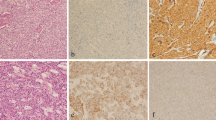Abstract
Our objective is to investigate the expression of CD147 and metallo-proteinase 9 (MMP9) in patients with basal-like breast cancer (BLBC) so as to determine whether these two genes may be correlated with prognosis of BLBC. We examined the expression of the CD147 and MMP9 in BLBC by immunohistochemistry. Furthermore, we analyzed the correlation between BLBC and several factors related to tumor progression, along with the prognostic value of BLBC. BLBC was significantly associated with CD147 and MMP9 expression (P = 0.000), and prone to lymph node metastasis and distant metastasis. Patients with BLBC showed shorter disease-free survival (P = 0.005) and overall survival (OS) (P = 0.011). In univariate analysis, CD147, MMP9, lymph node metastasis and clinical stage are independent prognostic factors affecting OS. In multivariate analysis, only clinical stage was identified as an independent prognostic factor. Patients with BLBC have a high expression of CD147 and MMP9; BLBC is correlated with a poor prognosis.




Similar content being viewed by others
References
Sorlie T, Perou CM, Tibshirani R, Aas T, Geisler S, Johnsen H, et al. Gene expression patterns of breast carcinomas distinguish tumor subclasses with clinical implications. Proc Natl Acad Sci USA. 2001;98:10869–74.
Cleator S, Heller W, Coombers RC. Triple-negative breast cancer: therapeutic options. Lancet Oncol. 2007;8:235–44.
Prati R, Apple SK, Gornbein JA, Chang HR. Histopathologic characteristics predicting HER2/neu amplification in breast cancer. Breast J. 2005;11:433–9.
Gown AM. Current issues in ER and HER2 testing by IHC in breast cancer. Modern Pathol. 2008;21:S8–15.
Billar JA, Dueck AC, Stucky CC, et al. Triple-negative breast cancers: unique clinical presentations and outcomes. Ann Surg Oncol. 2010;17 Suppl 3:384–90.
Sasa M, Bando Y, Takahashi M, Hirose T, Nagao T. Screening for basal marker expression is necessary for decision of therapeutic strategy for triple-negative breast cancer. J Surg Oncol. 2008;97:30–4.
Ramos-DeSimone N, Hahn-Dantona E, Sipley J, et al. Activation of matrix metalloprotease-9 (MMP9) via a converting Plasmin/Stromelysin-1 cascade enhances tumor cell invasion. J Biol Chem. 1999;274:13066–76.
Davidson B, Goldberg I, Berner A, et al. EMMPRIN (extracellular matrix metalloproteinase inducer) is a novel marker of poor outcome in serous ovarian carcinoma. Clin Exp Metastasis. 2003;20:161–9.
Guo H, Li R, Zucker S, et al. EMMPRIN (CD147), an inducer of matrix metalloproteinase synthesis, also binds interstitial collagenase to the tumor cell surface. Cancer Res. 2000;60:888–91.
Piao S, Zhao S, Guo F, et al. Increased expression of CD147 and MMP9 is correlated with poor prognosis of salivary duct carcinoma. J Cancer Res Clin Oncol. 2012;138(4):627–35.
Yu W, Liu J, Xiong X, et al. Expression of MMP9 and CD147 in invasive squamous cell carcinoma of the uterine cervix and their implication. Pathol Res Pract. 2009;205(10):709–15.
Li Z, Ren Y, Wu QC, et al. Macrophage migration inhibitory factor enhances neoplastic cell invasion by inducing the expression of matrix metalloproteinase 9 and interleukin-8 in nasopharyngeal carcinoma cell lines. Chin Med J. 2004;117(1):107–14.
Tang J, Zhou HW, Jiang JL, Yang XM, et al. Sig-h3 is involved in the HAb18G/CD147-mediated metastasis process in human hepatoma cells. Exp Biol Med. 2007;232:344–52.
Egeblad M, Werb Z. New functions for the matrix metalloproteinases in cancer progression. Nat Rev Cancer. 2002;2:161–74.
Mira E, Lacalle RA, Buesa JM, et al. Secreted MMP9 promotes angiogenesis more efficiently than constitutive active MMP9 bound to the tumor cell surface. J Cell Sci. 2004;117:1847–57.
Toole BP. Emmprin (CD147), a cell surface regulator of matrix metalloproteinase production and function. Curr Top Dev Biol. 2003;54:371–89.
Biswas C, Zhang Y, DeCastro R, et al. The human tumor cell-derived collagenase stimulatory factor (re-named EMMPRIN) is a member of the immunoglobulin super family. Cancer Res. 1995;55:434–9.
Zucker S, Hymowitz M, Rollo EE, et al. Tumorigenic potential of extracellular matrix metalloproteinase inducer. Am J Pathol. 2001;158:1921–8.
Rakha EA, El-Sayed ME, Green AR, et al. Prognostic markers in triple-negative breast cancer. Cancer. 2007;109:25–32.
Tischkowitz M, Brunet JS, Begin LR, et al. Use of immunohistochemical markers can refine prognosis in TNBC. BMC Cancer. 2007;7:134.
Bidard FC, Conforti R, Boulet T, et al. Negative phenotype accurately identify basal-like tumour? An immunohistochemical analysis based on 143 ‘triple-negative’ breast cancers. Ann Oncol. 2007;18:1285–6.
Tan DS, Marchio C, Jones RL, et al. TNBC: molecular profiling and prognostic impact in adjuvant anthracycline-treated patients. Breast Cancer Res Treat. 2008;111:27–44.
Sasa M, Bando Y, Takahashi M, et al. Screening for basal marker expression is necessary for decision of therapeutic strategy for triple-negative breast cancer. J Surg Oncol. 2008;97:30–4.
Cheang MC, Voduc D, Bajdik C, et al. BLBC defined by five biomarkers has superior prognostic value than triple-negative phenotype. Clin Cancer Res. 2008;14:1368–76.
Conflict of interest
All authors have no conflicts of interest.
Author information
Authors and Affiliations
Corresponding author
Rights and permissions
About this article
Cite this article
Liu, Y., Xin, T., Jiang, Qy. et al. CD147, MMP9 expression and clinical significance of basal-like breast cancer. Med Oncol 30, 366 (2013). https://doi.org/10.1007/s12032-012-0366-x
Received:
Accepted:
Published:
DOI: https://doi.org/10.1007/s12032-012-0366-x




